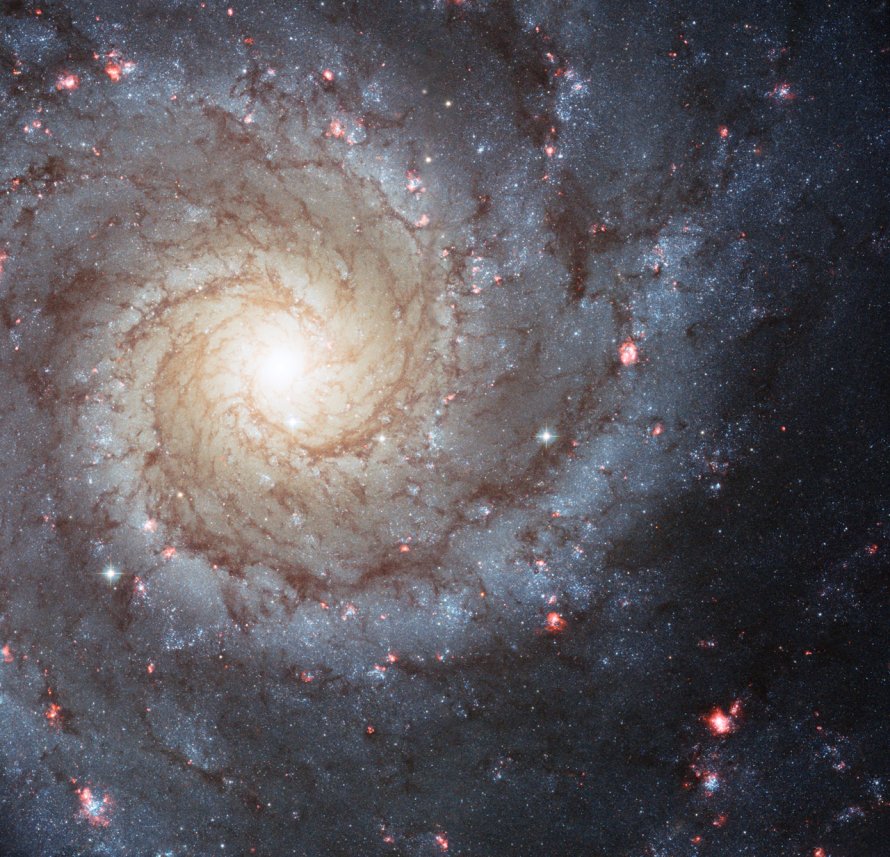M74 (NGC 628) - Phantom Galaxy
Messier 74 (NGC 628), also known as the Phantom Galaxy, is a spiral galaxy located in the constellation Pisces in the M74 Group of galaxies. M74 is 30000000 light years away from Earth.
M74 is best viewed during early spring, is magnitude 10, and can be viewed with small telescope. M74 is 10.5' x 9.5' in apparent size. For reference, the full moon is 30'.
Observing difficulty: Hardest
- Name:
- Phantom Galaxy
- Type:
- spiral galaxy
- Constellation:
- Pisces
- NGC or IC:
- NGC 628
- Magnitude:
- 10
- Viewing:
- small telescope
- Size:
- 10.5' x 9.5'
- Distance (light years):
- 30000000 LY
- RA:
- 1h 36.6m
- Dec:
- 15 48'
- Season:
- early spring
- Galaxy group:
- M74 Group
- Messier Marathon #:
- 2
* The naked eye can see up to magnitude ~7-8 objects under ideal dark sky conditions.
The Phantom Galaxy
Messier 74 (M74), also known as NGC 628, is a beautiful spiral galaxy situated in the constellation Pisces. It is often referred to as the Phantom Galaxy because of its low surface brightness, which makes it a challenging object for amateur astronomers to observe. This galaxy was first catalogued by the French astronomer Pierre M?chain in 1780 and subsequently included in Charles Messier's catalogue.
Characteristics of M74
M74 is a face-on spiral galaxy, which means we observe it from Earth almost directly above its galactic plane. This perspective gives us a beautiful view of its well-defined spiral structure, with its two main spiral arms clearly wrapping around a bright central region. Numerous smaller arm segments and spurs can be seen branching off from the main arms.
The galaxy's diameter is approximately 95,000 light-years, making it comparable in size to our own Milky Way Galaxy. M74 is also estimated to contain about 100 billion stars. Observations indicate that it is a relatively isolated galaxy with no significant interactions with other galaxies in its recent history, which might explain its well-preserved spiral structure.
Magnitude and Size
M74 has an apparent magnitude of 9.4, making it a challenging object for small telescopes under less than ideal viewing conditions. However, its low surface brightness is what makes this galaxy particularly difficult to spot. This faintness is due to the galaxy's light being spread out over a relatively large area in the sky?about 10.5 by 9.5 arcminutes, which is approximately a third the width of the full Moon.
Finding and Viewing M74
To find M74, one needs to locate its home constellation, Pisces, which is best seen in the autumn months for observers in the Northern Hemisphere. M74 lies near the easternmost star of the constellation's "Circlet" asterism, Eta Piscium. Roughly 1.5 degrees to the northwest of this star is where the Phantom Galaxy resides.
Viewing M74 requires a clear, dark sky free of light pollution, and even then, it might only appear as a faint, diffuse patch of light in small telescopes. Larger amateur telescopes under good conditions may start to reveal the galaxy's spiral structure, but this is generally more readily captured in long-exposure astrophotography.
In conclusion, M74 offers a splendid view of a face-on spiral galaxy, a view that is not common among the galaxies visible to amateur astronomers. Though its low surface brightness presents an observational challenge, successfully viewing this phantom galaxy can be a rewarding experience for the dedicated observer.



